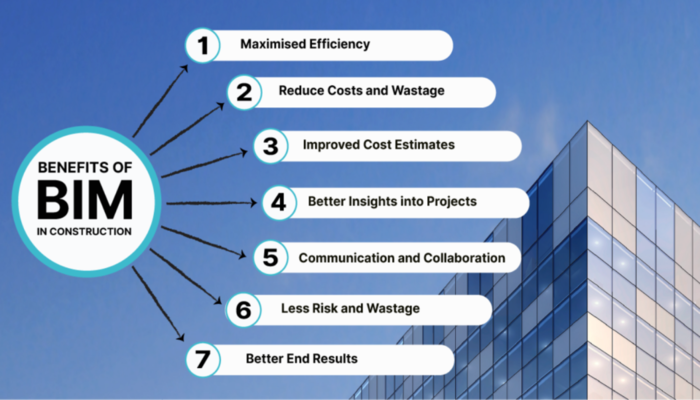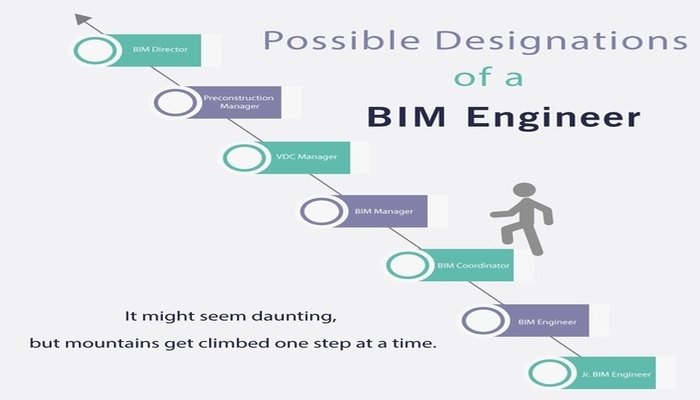The Growing Demand for BIM Civil Engineers in Multinational Companies

Table of Contents
What is Building Information Modelling (BIM)
Building Information Modelling (BIM) is a digital technology and methodology that is quickly becoming essential in the construction industry. It helps in design and the maintenance of a complete 3D digital model of a structure that contains all of its structural and functional details enhancing cooperation, communication, and efficiency of the building process. The use of BIM can result in decreasing error rates and well-informed decisions, which leads to cost savings and enhanced project results. All of these benefits and more are the reason why an increasing number of multinational companies (MNCs) are adopting BIM. With the global adoption of BIM, these MNCs are looking for more and more BIM professional civil engineers.
MNCs' Increasing Interest in BIM Civil Engineering
MNCs have been showing an increasing interest in civil engineering BIM professionals for several reasons, providing ample and attractive MNC civil engineering jobs for people fluent in BIM technology. BIM enables a collaborative and effective approach to construction and infrastructure development by creating a digital representation of a building's physical and functional qualities that can be easily shared across stakeholders. Below you will find an overview of the motivations for MNCs to adopt BIM in civil engineering:
- Efficiency and Cost Savings: BIM enhances project planning, design, and management. This leads to cost savings, improved coordination and timelines for large-scale civil engineering projects.
- Global Collaboration: BIM helps global collaboration among MNCs, regardless of their geographical location, enhancing their global operations.
- Risk Mitigation and Quality Assurance: BIM enhances risk assessment and management in civil engineering projects by providing real-time data, enabling informed decisions by MNCs to mitigate risks and ensure project success.
- Data-Driven Insights: BIM can generate vast amounts of data that can be utilised for data analytics and AI insights. MNCs use this information to enhance operational efficiency, maintenance, and sustainability in civil engineering projects.
- Sustainability and Environmental Considerations: The focus on sustainable construction and infrastructure development necessitates MNCs to reduce environmental impacts and enhance sustainability using BIM.
- Competitive Advantage: Early adoption of BIM gives MNCs a competitive edge, enabling them to offer clients more efficient and cost-effective solutions.
- Long-Term Benefits: Although implementing BIM may incur upfront costs, MNCs acknowledge the long-term benefits, such as improved project outcomes, reduced operational costs, and enhanced reputation.

BIM has become increasingly prevalent as a digital tool for project planning and execution. Therefore, the AEC industry is rapidly adopting this new-age tool across various verticals. Mentioned below is a breakdown of BIM implementation levels across various sectors within the AEC industry:
Among architectural firms, 89% report utilising BIM on at least half of their projects, indicating widespread adoption and integration of BIM into architectural design processes. Within the mechanical, electrical, plumbing (MEP) and structural sector, BIM is similarly prevalent, with 80% of firms using it extensively. In civil engineering, 72% of firms are leveraging BIM for a significant portion of their projects, highlighting its importance in infrastructure development. For other construction professionals also, BIM adoption remains strong, with 69% of firms employing it on a substantial portion of their projects. These statistics underscore the integral role of BIM in modern AEC practices, driving efficiency, collaboration, and innovation across the industry.
Benefits of BIM in Civil Engineering Projects
BIM is a comprehensive set of tools that foster collaboration among stakeholders such as architects, engineers, contractors, and owners. It provides a 3D visual representation of the project, enabling early identification of design issues. This helps minimise errors and conflicts, preventing delays and enabling better cost estimation. BIM also streamlines the construction process, optimising schedules, resulting in shorter project durations, reduced costs, and faster approvals and permits.
BIM offers data-driven insights for project managers, enabling scenario analysis and simulations to determine optimal construction methods and materials. It also assesses environmental impact, suggests sustainable design, and aids facility management, enabling efficient maintenance, operation, and renovation of infrastructure throughout its lifecycle.
BIM is a valuable tool that can detect clashes between building systems early in the design phase, preventing costly revisions during construction in civil engineering. It also ensures compliance with local building codes and regulations, reducing legal risks and project delays. BIM also performs safety analysis and simulations, improving worker safety on construction sites. It stores project data digitally, making it easier to access and share information among stakeholders. BIM models also aid asset management, allowing owners to track and maintain assets efficiently. It facilitates collaboration on international projects, improving construction quality and reducing maintenance costs.
Relevance Of BIM In The Construction Industry
- Enhances collaboration among stakeholders, enabling them to work on the same model simultaneously, reducing conflicts.
- Provides a 3D visual representation, improving design understanding and decision-making.
- Automates tasks like quantity takeoffs and cost estimation, saving time and reducing errors.
- Detects clashes in design, minimising costly rework and project delays.
- Links model elements to cost data for accurate financial decisions.
- Promotes sustainability by analysing environmental performance.
- Ensures compliance with codes and regulations, reducing legal risks and delays.
- Identifies and mitigates risks early in projects.
- Supports global collaboration between teams in different locations.
- Mandatory for public projects by many governments.
Read more: Passive Strategies for Building Design in Tropical Climates: A Comprehensive Guide
The Global Landscape: Why MNCs are Leading the Charge
Many top global civil engineering MNCs are leading the way in implementing BIM practices in the construction and infrastructure industries by increasing the demand for civil engineers. MNCs typically have more financial resources to invest in advanced technologies like BIM, which can result in better project efficiency and cost savings. Since MNCs often operate in multiple countries, they need streamlined communication and collaboration, which BIM provides through a common digital platform for project data. BIM helps MNCs reduce project risks by allowing for better design visualisation, clash detection, and accurate cost estimation. By adopting BIM early on, MNCs can remain competitive by delivering projects faster, more efficiently, and with higher quality. However, the most important reason towards the adoption of BIM by large companies is the need for standardisation across multiple construction projects.
The Need For Standardised Processes Across Projects
Standardised BIM processes in construction and infrastructure bring predictability, reliability, and improved quality assurance. They also enhance interoperability and reduce the learning curve for team members, while aiding in risk identification and mitigation.
By implementing standardised processes and increasing demand for civil engineers, workflows can be streamlined, which leads to efficiency gains and reduced project durations and costs. Accurate cost estimation and monitoring also contribute to effective cost control. Standardised processes for data management provide guidelines for effective organisation, storage, and retrieval of project data, facilitating global collaboration and enabling teams from different regions to work together seamlessly. Clients increasingly expect standardised BIM processes in their projects, which can improve client satisfaction and build stronger relationships. These adaptable processes ensure that organisations remain competitive as BIM technology evolves.
Lastly, standardised processes lead to consistent and comprehensive documentation and reporting, auditing, and performance evaluation. They are a cornerstone of successful BIM implementation in the construction and infrastructure industry, benefiting both project teams and owners.
Also Read: What is BIM management? What does the career role involve?
Case studies of MNCs successfully leveraging BIM
Here are some case studies that indicate how multinational corporations (MNCs) in the architecture, construction, and engineering (AEC) industry, have successfully used BIM (Building Information Modeling) to improve project efficiency, decrease costs, and enhance collaboration. BIM is used to simplify processes, enhance communication, and minimise mistakes has made it a valuable resource for MNCs to complete projects.
1. Dar-Al-Handasah, Beirut, Lebanon
Year of Establishment:1956
Key Features: Dar offers planning, design, management, and consulting services for the most significant and fascinating projects all over the world. They accept challenges to strengthen communities with their skilled team. They use BIM to improve projects by facilitating collaborative design coordination, creating 3D models, and providing data-driven insights. This approach puts Dar Al-Handasah at the forefront of innovative and efficient project delivery. Some of their projects include the expansion of the Suez Canal in Egypt. In Angola, their projects related to water, parliament, and electricity have helped the country recover from decades of civil strife.
2. Skanska, Sweden
Year of Establishment: 1887
Key Features: Skanska, a well-known construction firm with a global presence, utilises the power of Building Information Modeling (BIM) to effectively manage projects, create detailed 3D models, and promote cost-effective construction practices. BIM's potential to optimise project logistics, detect clashes, and schedule construction is highly valued by Skanska, and they prioritise its use to ensure the timely delivery of projects within budget. Skanska's commitment to excellence and efficiency has established its leadership position in the construction industry.
3. Mott MacDonald, United Kingdom
Year of Establishment: 1989
Key Features: Mott MacDonald uses BIM for collaboration, 3D modelling, and project management efficiency. Their BIM approach encourages multidisciplinary teamwork, allows for detailed 3D project modelling, and optimises project schedules and resource utilisation. They prioritise quality control through clash detection and data-driven decision-making to ensure project accuracy. Their designs are energy-efficient, integrating sustainability principles. BIM-driven efficiencies result in cost savings, while compliance with industry standards ensures regulatory adherence and consistency. They engage their clients with BIM models and continuously develop their skills in BIM technologies to enhance their successful BIM strategy.
4. Turner Construction, United States
Year of Establishment: 1902
Key Features: Turner Construction is a multinational construction company that uses BIM for clash detection and resolution during construction. They work on large and complex projects, prioritising innovation and utilising emerging technologies to benefit their clients, employees, and community. With a long-standing reputation for integrity, safety, and delivering challenging projects, Turner Construction is committed to driving innovation and advancing the industry as a whole.
5. Neilsoft, Pune
Year of Establishment: 1993
Key Features: Neilsoft offers clients in numerous technical sectors specialised engineering services and solutions. They want to increase engineering productivity, encourage international trade, and boost competition. By establishing an effective global delivery strategy for engineering projects, they have become the go-to partner for prominent international corporations.
Skills and Expertise Desired by MNCs in BIM Civil Engineers
Here's a list of skills and expertise desired by top MNCs:
- Proficiency in BIM software
- Revit
- AutoCAD Civil 3D
- Navisworks
- 3D modelling skills
- Creating and managing 3D models
- Data analysis skills
- Analysing BIM data for informed decision-making
- Problem-solving skills
- Interpreting BIM data to solve engineering problems
- Familiarity with collaboration tools
- BIM 360
- Procore
- Communication skills
- Ensuring smooth communication in BIM-integrated projects
- Real-time information exchange
- Utilising collaboration tools for real-time data sharing
- Construction project management
- Strong knowledge of construction project management
- BIM-integrated project management
- Managing projects with BIM integration
- Contribution to sustainable construction
- Highlighting the importance of design principles
- Implementing green building practices
These skills collectively make a BIM Civil Engineer well-equipped to meet the demands of MNCs.
Civil Engineering Job Market Trends and How They Shape BIM Roles for Civil Engineers
The civil engineering job market is evolving due to several trends. BIM civil engineers are increasingly required to possess proficiency in BIM tools, such as 3D modelling and clash detection, as well as expertise in sustainable design and eco-friendly practices. They must also collaborate seamlessly with global teams, ensuring smooth data flow between stakeholders. BIM generates a lot of data, necessitating data-savvy engineers proficient in analytics tools. Additionally, there is a push for project efficiency and cost control, with BIM playing a crucial role in streamlining workflows and minimising clashes. As a result, BIM engineers are increasingly taking on project management roles to ensure cost-effective and timely project delivery.
Read more: 10 Gravity-Defying Structures That Will Leave You Awestruck
Career Growth of BIM Civil Engineer
The career growth of a Building Information Modeling (BIM) civil engineer in India can be quite promising as BIM technology continues to gain importance in the construction and civil engineering sectors. Here's an overview of the career growth path and estimated BIM-related salaries in Indian Rupees (INR) for civil engineering professionals:
1. Entry-Level BIM Civil Engineer (0-2 years of experience)
Salary: INR 2,00,000 to INR 4,00,000
As entry-level professionals, their primary duties are to generate and manage BIM models, perform data input, and carry out essential design tasks.
2. BIM Coordinator/Modeler (2-5 years of experience)
Salary: INR 4,00,000 to INR 8,00,000
BIM coordinators or modellers play an essential role in the development and management of BIM models. They coordinate and ensure data accuracy and consistency are maintained throughout the project.
3. Senior BIM Specialist/Consultant (5-8 years of experience)
Salary: INR 8,00,000 to INR 15,00,000
Senior BIM specialists and consultants manage the implementation of BIM, which includes setting and enforcing standards, managing teams, and playing a critical role in the overall strategy and execution of projects. Their expertise is essential for the successful implementation of BIM technology and processes.
4. BIM Manager/Coordinator (8+ years of experience)
Salary: INR 15,00,000 to INR 25,00,000
BIM Managers/Coordinators maintain an in-depth understanding of complicated BIM challenges and are skilled at resolving issues that may arise during the BIM process. Additionally, these experts can guide adoption strategies to ensure the implementation of BIM is successful.
5. Director of BIM/VP of BIM Department (Highly experienced)
Salary: INR 25,00,000 +
At the upper level of construction companies or engineering firms, individuals are responsible for overseeing the entire BIM departments, Director or Head of the BIM Department. They occupy executive positions and are responsible for charting the strategic course for BIM implementation within their respective organisations.
| Designation | Salary (INR) | Experience (years) |
| Entry-Level BIM Civil Engineer | 2,00,000 - 4,00,000 | 0-2 |
| BIM Coordinator/Modeler | 4,00,000 - 8,00,000 | 2-5 |
| Senior BIM Specialist/Consultant | 8,00,000 - 15,00,000 | 5-8 |
| BIM Manager/Coordinator | 15,00,000 - 25,00,000 | 8+ |
| Director/VP | 25,00,000+ | 15+ |
The Future of BIM and Civil Engineering in MNCs
The use of BIM in civil engineering by MNCs is set to change the industry. BIM is becoming the industry standard and transforming how projects are planned, designed, and managed. MNCs will adopt advanced BIM technologies to improve collaboration, data analytics, and automation. Sustainability will be a key focus, with BIM supporting eco-friendly designs and green construction practices. Global collaboration will also increase, making it possible for MNCs to work on international projects with ease. The evolution of BIM will require a skilled workforce with expertise in data analysis, automation, and emerging technologies. Ultimately, BIM will improve efficiency, streamline processes and drive innovation in civil engineering across MNCs, shaping a more sustainable and interconnected future.
Conclusion
BIM-specialised civil engineers in India have a promising career path with growth opportunities and salaries ranging from entry-level to senior leadership positions. As professionals gain expertise, their roles evolve to successfully implement BIM in the industry, driving efficiency, innovation, and sustainability in the construction and infrastructure sectors. This will eventually shape a more interconnected and sustainable future for civil engineering, with opportunities in leading civil engineering MNC companies.
If you are a civil engineer looking to expand your knowledge of BIM, Novatr offers a BIM professional course for civil engineers taught by industry experts with extensive real-world experience. The course covers new technologies that can aid in creative and streamlined work processes.

 Thanks for connecting!
Thanks for connecting!
-1.png)



.png)






